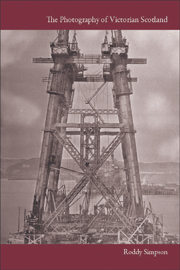Book contents
- Frontmatter
- Contents
- List of Figures
- Introduction
- 1 The Origins of Scottish Photography: Pioneering Activities in St Andrews and Edinburgh
- 2 David Octavius Hill and Robert Adamson: the ‘Partnership of Genius’ and the First Art Photography
- 3 Photography for the Few: The Activities of the Enthusiastic and Artistic Amateurs
- 4 Photography in Demand: The Work of the Increasing Number of Professional Photographers to Meet Public Demand
- 5 Scots Abroad: The Achievements of Scottish Photographers Around the World
- 6 Tourists and Travellers: Images of Scotland Produced for the Rapidly Growing Tourist Market and Photographs Taken by Visitors
- 7 Recording Social Conditions and Industrial Change: Photographs of what was Being Lost and what was Replacing it
- 8 Photography as Art: Looking at the Images and the Arguments
- 9 Populist Activity and Pictorialism: Popular Involvement with Cheap and Mass Produced Cameras and Photographers with Artistic Aspirations
- 10 Scotland's Enduring Photographic Legacy
- Bibliography
- Acknowledgements
- Index
4 - Photography in Demand: The Work of the Increasing Number of Professional Photographers to Meet Public Demand
Published online by Cambridge University Press: 05 August 2013
- Frontmatter
- Contents
- List of Figures
- Introduction
- 1 The Origins of Scottish Photography: Pioneering Activities in St Andrews and Edinburgh
- 2 David Octavius Hill and Robert Adamson: the ‘Partnership of Genius’ and the First Art Photography
- 3 Photography for the Few: The Activities of the Enthusiastic and Artistic Amateurs
- 4 Photography in Demand: The Work of the Increasing Number of Professional Photographers to Meet Public Demand
- 5 Scots Abroad: The Achievements of Scottish Photographers Around the World
- 6 Tourists and Travellers: Images of Scotland Produced for the Rapidly Growing Tourist Market and Photographs Taken by Visitors
- 7 Recording Social Conditions and Industrial Change: Photographs of what was Being Lost and what was Replacing it
- 8 Photography as Art: Looking at the Images and the Arguments
- 9 Populist Activity and Pictorialism: Popular Involvement with Cheap and Mass Produced Cameras and Photographers with Artistic Aspirations
- 10 Scotland's Enduring Photographic Legacy
- Bibliography
- Acknowledgements
- Index
Summary
Photography quickly became an important and pervasive part of Victorian society reflecting tastes and interests. In an atmosphere of consumerism there was huge demand to own photographs and commercial photographers responded to this, resulting in an almost industrial level of production.
There is a distinct contrast to Chapter 3. The photographers looked at then were free from commercial considerations and could take a personal and individual approach to their photography. They could afford to indulge themselves, be innovative, experiment and make mistakes. This chapter is about photography as a product where the purpose was to produce images which would sell and cater to popular demand. This photography was only innovative in improving the efficiency of the means of production, introducing different product lines and responding to changes in taste. Quality and originality in the image produced was not the over-riding consideration. However, among the mass of commercial photographers, while many were undistinguished, there were some very competent practitioners and a few whose work transcended commercial considerations.
The rise of commercial photography started in 1851 with a discovery from an unlikely source. Frederick Scott Archer (1813-57), who was a sculptor by profession and a keen amateur photographer, discovered a method for sensitising glass plates which became known as the wet collodion process. Glass had been thought of as the ideal backing for photographic negatives but the difficulty was getting the sensitising material to stick to the glass surface. It was Archer who utilised the recently discovered collodion as the sub-stratum coating to adhere to the glass. His method was published in The Chemist magazine in March 1851 but Archer did not patent or try to profit from his invention.
- Type
- Chapter
- Information
- The Photography of Victorian Scotland , pp. 68 - 89Publisher: Edinburgh University PressPrint publication year: 2012

